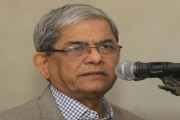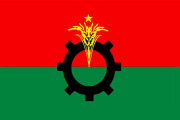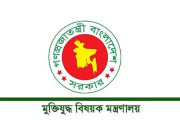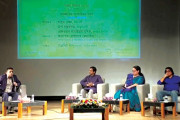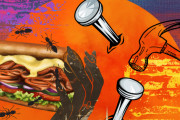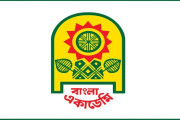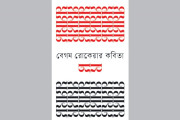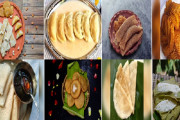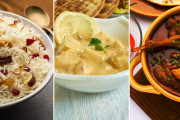।। M. Abdul Momin ।।
Since independence population increased two-and-half fold but rice production has increased more than three-and-half fold which reflects the success story of rice scientists, extension agents and farmers with the strong support of a pro-agriculture government
Bangladesh is proud to have many success stories over the years, especially in achieving self-reliance in production of food, livestock and fishery in the country. Here is one such success story. Legends speak that once upon a time households in Bangladesh were abundant in rice, fish and cattle. However, being a small deltaic country of land scarcity, the rise of population, depletion of cultivable land, repeated natural calamities and series of famines led to decline in rice production. Bangladesh became a land of chronic food deficit. In 1971 with our independence, we inherited a food deficit country. Achieving self-reliance in rice production is in a sense synonymous with the rise of Bangladesh. As the staple food of our people, rice is synonymous with food security for Bangladesh.
Historically, we was never been food sufficient. We were always been in chronic food shortage. Millions of people had died in famine and several millions had suffered from hunger and malnutrition. Even after independence the situation did not improve that much. Realizing this critical scenario Father of the Nation Bangabandhu Sheikh MujiburRahman urged the agricultural graduates and scientists in 1973 at Bangladesh Agricultural University (BAU) to produce more rice to meet the requirement of country’s ever-increasing population because he was unable to procure rice anywhere from the world despite putting all sorts of his efforts. So, his one of the priority policies was to make Bangladesh self-reliant in food production. Inspired by his directives, the rice scientists of Bangladesh with their relentless efforts innovate various (HYV) High Yielding Varieties of Rice.
In the mid-seventies the “miracle rice” IR8 and revolutionary year-round rice variety BR3 has brought first breakthrough in our national food production. After Bangabandhu’s unfortunate assassination, the revolution was stopped for a long-time. In 1996 Bangabandhu’s worthy daughter Prime Minister Sheikh Hasina came up in power with a landslide victory in national parliamentary elections and took all necessary steps to boost up production and make the country self-sufficient. And for the first time we achieved self-sufficiency in food especially in rice. The prime minister was awarded the prestigious Ceres Medal by the Food and Agriculture Organization (FAO) for this tremendous achievement.
Since independence population increased two-and-half fold but rice production has increased more than three-and-half fold which reflects the success story of rice scientists, extension agents and farmers with the strong support of pro-agriculture government led by Prime Minister Sheikh Hasina. Again in 2013, she made the country not only self-reliant in food but also enabled us as food surplus country. Bangladesh started exporting rice. Bangladesh Rice Research Institute (BRRI) is a one of key contributors behind this tremendous achievement.
In 2015, BRRI has formulated Rice Vision for 2050 and beyond; estimating projected rice requirement for 2030, 2041 and 2050. The projected requirements are 36.5, 42.0 and 44.8 million tons respectively, to meet the demand of 180, 203 and 215 million people. To achieve these milestones, our production target would be 40, 44 and 48 million tons respectively, having a surplus of about 3.0 MT per year. Using our high yielding new varieties and new technologies we got the momentum and already exceeded the production target. For example, during the last ten years (2009-19), rice production has increased @ 0.6 MT year-1 and this year it will be even more than expecting rate.
According to recent statistics of USDA, Bangladesh has had the highest average rice yield in South Asia and at per world standard. During 2019-20 production years, Bangladesh is going to clinch third place beating Indonesia in global rice production with an increased output of 38.54 million tons enabling surplus of 4.0 MT meeting requirements for 167.0 million people including 1.2 million ROHINGYA refugees. Bangladesh has emerged as a global model for combating hunger and obtained great success in becoming a country of food surplus from chronic food shortages. At the time of its independence in 1971, it was beyond anyone’s imagination that a tiny piece of land in the South Asian region called Bangladesh will perform so tremendously that it will exceed several domestic as well international agencies’ targets on economic performance.
Initially, BRRI’s main target was to produce more rice in less land and feeding the ever increasing population of the country. But with the increase of per capita income and socio-economic condition demand and taste of the people have been changed. Now, they prefer slender and nutritious rice. Moreover, Bangladesh will have to fulfil the goals of SDG by 2030 and one of the important goals of SDG is doubling the productivity along with nutritious and safe food. So, BRRI has given special emphasis on producing nutrient enriched and export quality premium rice varieties. With yield and yield contributing attributes scientists are giving more importance to nutrient attributes in on-going and future rice research and development plan.
BRRI has so far developed and released 102 modern varieties (95 Inbreed and 7 Hybrid) of them 24 are stress tolerant of which 10 are saline tolerant, 3 submergence, 3 drought, 4 cold, 2 tidal submergence, 1 semi-deep water and 1 dual tolerant (Sal+Sub). In addition, 13 premium quality, 5 Zn-enriched and 3 Low GI (Glycemic Index) rice for diabetic patients have been developed. It is reported that, more than 80% of total rice area of the country has been covered by BRRI released variety and its contribution to national rice production is about 91%.
We know, rice is a major crop in Bangladesh which provides >70% calories and >65% protein. Therefore, rice is not just only a food or commodity for Bangladeshis but it is one of the daily necessities for the people. We used to say, rice is life in Bangladesh. If we failed to produce sufficient rice, millions of people would have been food refugees and crores of people might have died. Moreover, we have to spend most of our domestic income for importing food and feed. But instead of struggling for food and poverty reduction, Bangladesh is now showing courage to take and implement costly projects from its national incomes. Among other key development indicators, this has been visualized by world famous media “South China Morning Post” in a piece titled, “The Big Story: The Rise and Rise of Bangladesh.” But behind the entire success indicator the biggest secret was our persistent food security. So behind the big story we want to say “Rice is Rise in Bangladesh”.
The writer is Senior Liaison Officer, Bangladesh Rice Research Institute (BRRI), Gazipur-1701. Email: smmomin80@gmail.com






















